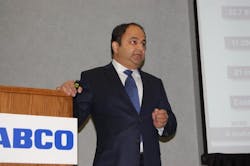Meritor WABCO unveils ProView performance analysis system
LOUISVILLE. Meritor WABCO is rolling out a new performance management system dubbed “ProView” to help fleets improve safety and operational efficiency.
Developed jointly with SmartDrive Systems, ProView – available starting in May this year – combines analysis of engine and vehicle data collected by Meritor WABCO technology with SmartDrive’s in-cab video and driver measurement capabilities to offer what the two companies term a “personalized driving performance improvement program” with predictive analytics to help reduce collisions and improve fuel efficiency.
“By offering video and data analytics and delivering critical event video content fast, fleets can identify and significantly reduce potentially dangerous situations,” noted Jon Morrison, president and general manager for Meritor WABCO, during a press conference here at the 2014 Mid America Trucking Show.
“This creates a more complete picture of what’s happening on the road, not just in terms of accident reconstruction but in terms of driver coaching capability,” he explained. “ProView takes this enormous amount of data coming from the vehicle and the driver and prioritizes it for the fleet; helping improve operating efficiency while lowering risk.”
Morrison added that ProView will also be offered with what he called an “online discussion forum” as well.
The video feature of ProView, said Morrison, is similar to “game film” analysis used by experts during televised sporting events and is designed to help unify vehicle, driver and driving data. Fleet managers have access to the video through SmartDrive’s Web-based back-office application while drivers can access the video directly through a smartphone app.
“WABCO shares a vision with us,” Steve Mitgang, SmartDrive's CEO, told Fleet Owner in an interview during the Truckload Carriers Association (TCA) annual convention in Dallas, TX also being held this week. “The integration of data and services should lead to even safer vehicles. Analytics should be about powerful, actionable insights. They should provide users with an action plan."
He added that the "right" solution should be subtractive as it should let you stop doing something you were doing before, like studying dashboards.
“Measuring risky driving can help fleets improve safety, reduce collision costs and lower fuel expenses,” WABCO's Morrison explained. “Fleets can prioritize coaching with a focus on high-impact areas, such as following-distance violations, excessive idling and acceleration, stability events, rolling stops and driver inattention. Recorded video data can also validate safe driving practices among a fleet’s operators.”Nikhil “Nik” Varty (seen at right), Meritor WABCO’s president of the Americas, added that products like ProView are part of the company’s overall effort to broaden its market reach in transportation. For example, he noted that Meritor WABCO purchased European fleet management system provider Transis in February for $150 million – a company with 1,300 fleet customers – with plans to expand Transis’ service offerings to other trucking markets such as North America in the Middle East down the road.
“There are two challenges faced by the trucking industry: one from a cost perspective, the other from a regulatory perspective,” Varty said. “We see a lot of room for growth in the North American market for products that improve safety and fuel economy while providing a strong ROI [return on investment]. We’re trying to embrace the power of what we can provide customers.”
The company also announced new fuel-saving electronic air processing technology for the North American truck market.
The System Saver 1200 Plus air dryer technology with electronic fuel-saving software is stored in Meritor WABCO’s anti-lock braking system. Integration of these advanced technologies with the new connectivity solution reduces system cost for OEMs and helps fleets improve fuel efficiency.
“We’ve developed a highly intelligent and cost-effective air processing system that will improve vehicle efficiency and boost fuel savings by up to 1 percent for North American fleets,” said Patrick Kealy, director, Compression and Braking for Meritor WABCO. “The new technology is specifically engineered to the needs of North American vehicle makers and fleets.”
The high-capacity dryer uses internal air for regeneration, providing a more efficient solution. Meritor WABCO’s air dryer system differentiates with best-in-class air drying capacity, lighter weight, lower maintenance costs and higher fuel savings.

